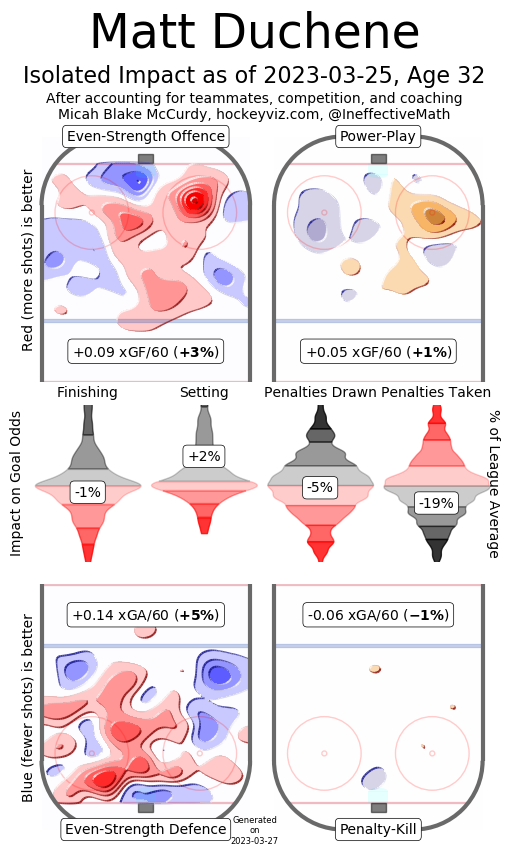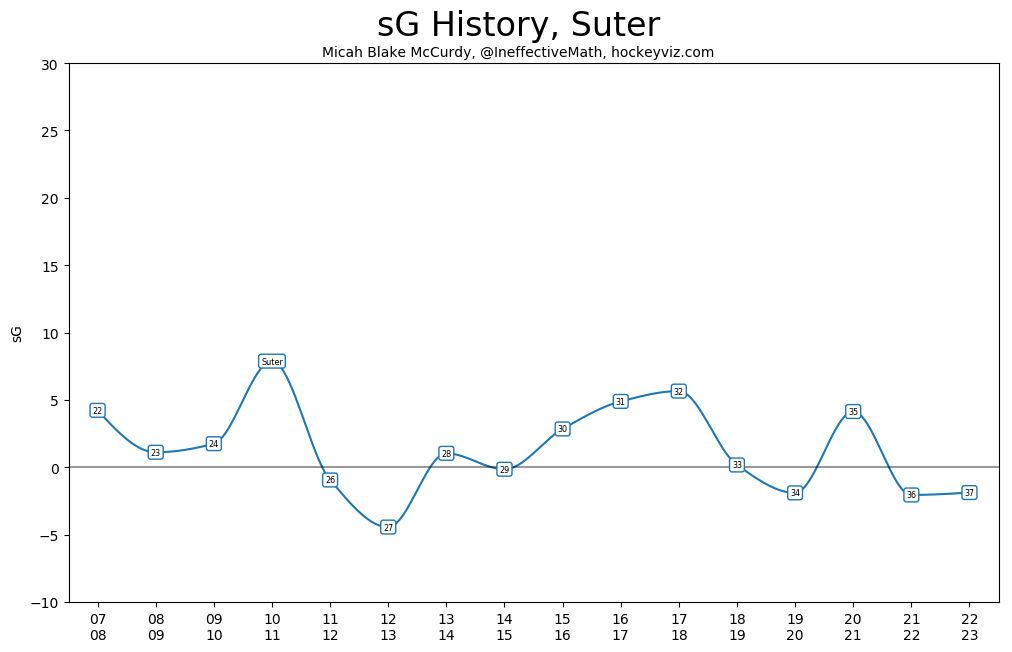In laymen's terms, what is Micah Blake McCurdy's new model all about?
Let's have a discussion about analytics. And then let's talk about "sG."
I think analysis is important, but I’m not a mathematician. I took a Statistics class in college, and all I remember about high school algebra is the word “polynomial.” Truth is, I don’t know shit about math or models. If you were to ask me what a coefficient is, or how to define ridge regression I would immediately want to be anywhere but here. I don’t have a mind for any of this.
But I do have a stomach for it. As a hockey writer, I feel like this should be part of the job. There’s no quicker way to cut through some BS talking point than to simply do the math. How can you offer people analysis of the game if you can’t articulate a player’s impact, their context, their performance or their value?
Notice I didn’t mention any numbers. I talked about:
impact
context
performance
value
That’s ultimately what these numbers are for. Corsi and expected goals help us develop a better language about a player’s contributions (impact). Player usage and quality of competition help us better define their roles (context). Corey’s tracking data communicates more to us about a player’s process (performance), and Wins Above Replacement designate what some of these stats add—or don’t—up to (value). We all know that Wyatt Johnston is good. But do we know that Wyatt Johnston belongs in a class of teenage forwards who average 54 points in their follow-up seasons? Again, language: now we have specific frames of reference to discuss Johnston’s value instead of Good versus Bad.
However, just as analytics help us develop that clearer language, analytics themselves develop also. Whatever they do or mean, they rely on premises their human creators have outlined. This is why Dom Luszczyszyn’s model—which started out as the baseball-inspired stat called Game Score—underwent changes many years ago when a lot of defensive teams were having success. Now instead of including those changes within his existing model, his latest model is a net rating system that separates the offensive and defensive rating of a player. Corey Sznajder’s tracking data has undergone significant changes after finding too much noise in merely calculating zone entries. Micah Blake McCurdy of Ineffective Math is now doing something similar with his introduction of “sG” or synthetic goals.
McCurdy’s work has always stood out not just because they’re pretty. (Here’s new victory green kid on the block, Matt Duchene.)
But also because there’s no single number to distract us from broader discussions about player value.
Starting from the top left, Duchene increases the chances of his teams scoring a goal by three percentage points (the +3). Going to the top right, he’s a net positive on the power play, but unlike at ES where he’s dangerous all over, on the PP he’s only dangerous on the right dot. Moving to the middle, he decreases his team’s ability to score by one percentage point (this might seem like a contradiction but xG models are a broad assessment of player impact on shot quality whereas Micah’s “finishing” stat is a specific assessment of a player’s impact on offense per shot). His setting impact, an evaluation of player passing, is good. While he doesn’t draw penalties, he doesn’t take them either. Finally, his teams are five percentage points more likely to allow a goal with him on the ice, though he’s oddly decent on the penalty kill.
Sidebar: The reason why you see penalties drawn/taken included into expected goal models a lot is because at even strength, a two-minute stretch of hockey has an 8 percent chance of yielding a goal. A two-minute stretch on the power play, however, has a 24 percent chance of yielding a goal. So it’s kind of a big deal.
So about this sG. What is it exactly? How are synthetic goals different from expected goals? Synthetic goals will be Micah’s version of a single value stat. They’ll take all the stuff you see above from that Duchene card and then throw it a separate math pot. This new math pot will yield a different number based on one thousand minutes of EV time, 200 minutes of PP time, and 200 minutes of PK time. Why the separate math pot?
To give a player a sense of imminent value from shift to shift. The end result is a number that may or may not give us more predictive language. Think of this stat as the scheduled value of a player.
For some added insight, here’s Micah explaining how EV shot rates will translate into sG.
The conversion for 5v5 shot rate impact is the simplest. For example, at time of writing, Sidney Crosby's isolated impact on 5v5 offence is 0.31 xG per hour (that is, per 5v5 hour). Thus, in a thousand 5v5 minutes, this amounts to 5.17 xG; leaving aside for the moment that some of these shots will be taken by Crosby himself, assuming the shots are taken by league average shooters, with league average setters, and against league average goaltenders, the 5.17 xG should become 5.17 goals. Thus, this skill is worth 5.17 sG. His defensive impact is currently more modest, just -0.05 xG per hour, so his defensive ability over a thousand minutes is -0.83 xG, that is, Crosby's imagined opponents can be expected to score 0.83 fewer goals than they would have scored had Crosby been replaced with a league-average player at this skill. These two impacts are felt in two different areas (goals scored and goals allowed) but they can be gathered together to give a total of almost exactly 6.00 sG.
So now what? I realize some readers will (respectfully) not give a shit. Trying to understand all of this is my job, not yours. And guess what? I totally respect that. Analytics are important for what I do, but they’re not important to enjoying the game. Granted, I know the readership here at Stars Stack (yea I changed the name, although I’m still trying to figure this one out) is different. But I never want analysis to feel bogged down by the weeds of the information. And I completely sympathize with those who tune this stuff out.
My agenda when it comes to analytics is that they’re essential to understanding hockey in more detail, and hockey coverage should do a better job of communicating them to casual fans. My agenda is not that you should believe them.
The reason I’m talking about sG is that you can expect to see me use it in the future. When you do, I hope you have some context about why. It’s the kind of stat that might be especially useful for players owed more then what they’ve been rewarded for...
Or who are owed less, and the punishment’s simply due…
I recommend reading Micah’s explanation in its entirety. These public models do a lot to help us understand the game better, and I always consider it a huge courtesy for the mathematicians and model makers to explain what they do and why.








I think most fans want something simple and tangible, and this is an attempt at that. Clearly something you'd want to merge with their WAR and other all encompassing stats. Something nice to see, and clearly ammo when you want to praise or dump on specific players...
So, am I understanding this correctly? According to Micah's numbers, Duchesne would have an even-strength sG of .05?